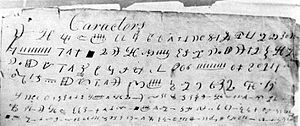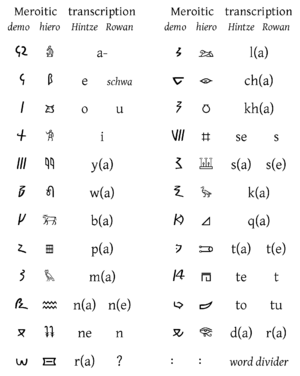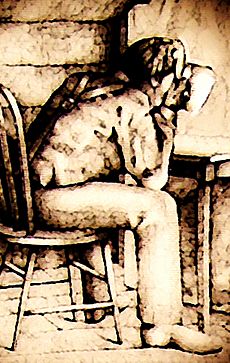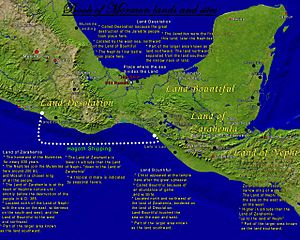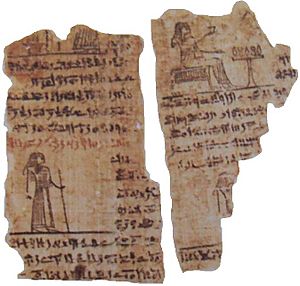Criticism of the Book of Mormon facts for kids
The Book of Mormon is a special book for people who follow the Latter Day Saint movement. They believe it contains writings from ancient prophets who lived in the Americas from about 2200 BC to AD 421. The book was first published in 1830 by Joseph Smith. He said he translated it from "golden plates" that were written in a language called "reformed Egyptian."
Many people who follow the Latter Day Saint movement see the Book of Mormon as holy scripture. They also see it as a historical record of how God interacted with ancient people in the Americas.
However, many scholars and experts have questions about the Book of Mormon's origins. They believe Joseph Smith created the book himself. They think he used ideas and materials from his own time in the 1800s, rather than translating an ancient record. For example, they say there is no proof that a language called "reformed Egyptian" ever existed.
Experts have also found things in the book that don't seem to fit the time period it describes. These are called anachronisms. Also, archaeological and genetic evidence does not support some of the book's claims about the ancient people of the Americas. The book has also been changed many times since it was first published. Critics say these changes show it might not have come from a divine source.
Despite these questions, people who believe in the Book of Mormon, and many Latter Day Saint scholars, defend it. They point to the testimonies of the Three Witnesses and the Eight Witnesses. These people said they saw the golden plates. Their statements are printed in every copy of the Book of Mormon. Some scholars also suggest that "reformed Egyptian" could be linked to an ancient Egyptian language. A few Latter Day Saint scholars also believe archaeological findings support the book, though most mainstream scholars disagree.
Contents
Where Did the Book Come From?
Many scholars do not agree with Joseph Smith's story about how the Book of Mormon came to be. Smith said the book's text came from an ancient record written on golden plates. He also said God gave him and a few others the power to translate it into English.
Critics point out that there is no physical proof of the golden plates. Smith said an angel named Moroni showed him where to find the plates. He also said the angel took the plates back after he finished translating them. To support the idea that the plates existed, Smith included statements from several witnesses in the book. These statements are usually found at the beginning of the Book of Mormon.
The Golden Plates: Fact or Fiction?
Two groups of witnesses, three people and eight people, said they saw the golden plates. These were the records Joseph Smith said he translated. However, three of the witnesses (Martin Harris, Oliver Cowdery, and David Whitmer) later left the church. They thought Joseph Smith was no longer a true prophet. Harris and Cowdery later rejoined the church.
Critics question these testimonies for different reasons. One reason is that most of the witnesses were related to each other. Also, Martin Harris, one of the witnesses, later said he saw the plates with a "spiritual eye" or "eye of faith."
People who support the Book of Mormon say that the witnesses stood by their statements until they died. David Whitmer, who never returned to the church, even signed a statement in 1881 saying his experience was true.
Most language experts, archaeologists, and historians do not believe the Book of Mormon is an ancient text. Some theories suggest that Joseph Smith wrote the book himself. He might have had help from Oliver Cowdery and Sidney Rigdon. They might have used information from books popular at the time. These could include the King James Bible and other writings.
The Language of the Book
Joseph Smith said he translated the Book of Mormon from a language called "reformed Egyptian." However, archaeologists and experts in ancient Egypt have found no proof that this language ever existed.
One supporter, Hugh Nibley, suggested that "reformed Egyptian" might be related to an ancient language called Meroitic Egyptian.
The official Church of Jesus Christ of Latter-day Saints says that some ancestors of Native Americans came from the Jerusalem area. But language experts who study Native American languages have not found any links to ancient languages from the Near East.
Supporters also point to interesting ideas in the Book of Mormon about creation. They say these ideas are similar to ancient Egyptian texts about temples, tombs, or coffins. These Egyptian texts were not understood by scholars until long after the Book of Mormon was published.
Another point supporters make is that the Book of Mormon uses chiasmus. This is a special way of writing where ideas are repeated in a reversed order. They say this shows the book is ancient. However, critics like Jerald and Sandra Tanner argue that chiasmus was just part of Joseph Smith's way of speaking. They point out that chiasmus is also found in the Doctrine and Covenants, which was not translated from an ancient text.
Joseph Smith was known for searching for treasure before he said he found the golden plates. Some scholars suggest he might have gotten names like "Cumorah" and "Moroni" from stories about the treasure hunter Captain William Kidd. Kidd's stories mentioned a place called Moroni, Comoros.
How the Book Was Translated
Joseph Smith only said one thing about how he translated the book. He said it was "through the medium of the urim and thummim... by the gift and power of God." Martin Harris and David Whitmer, who saw Smith working, said he translated it word-for-word.
Today, scholars in the Church of Jesus Christ of Latter-day Saints have different ideas about the translation. Some believe Smith had very little freedom in choosing the words. Others think that God gave Smith the ideas, and he put them into his own words.
Old Bible Language in the Book
The Book of Mormon claims to be the original writings of ancient leaders in America. However, it contains many phrases and quotes from the 17th-century King James Bible (KJV). Joseph Smith's Bible also had other books called deuterocanonical books. The language in the Book of Mormon often sounds like the old English used in the KJV.
The Book of Mormon quotes about 25,000 words from the KJV Old Testament. It also quotes over 2,000 words from the KJV New Testament.
There are many times when the writers in the Book of Mormon use words from the New Testament. This is surprising because they would not have had access to the New Testament. Here are a few examples:
| Book of Mormon Text | KJV Text |
|---|---|
| "the kingdom of God, which was prepared for them from the foundation of the world (2 Nephi 9:18) | "the kingdom prepared for you from the foundation of the world (Matthew 25:34) |
| "he judgeth, and his judgment is just" (Mosiah 3:18) | "I judge: and my judgment is just" (John 5:30) |
| "he who is filthy shall remain in his filthiness" (Alma 7:21) | "he which is filthy, let him be filthy still" (Revelation 22:11) |
There are also similarities with the Deuterocanonical Books. For example, the name "Nephi" appears in 2 Maccabees.
| Deuterocanonical | Book of Mormon (1830) |
| "We will assay to abridge in one volume ... labouring to follow the rules of an abridgment ... But to use brevity ... is to be granted to him that will make an abridgement." (2 Maccabees 2:25-31) | "I make an abridgement of the record ... after I have abridged the record ... I had made an abridgement from the plates of Nephi ... I write a small abridgement." (1 Nephi 1:17, Words of Mormon 3, 5:9) |
| "Then the king, in closing the place, made it holy ... many men call it Nephi". (2 Maccabees 1:34,36) | "And my people would that we should call the name of the place Nephi; wherefore we did call it Nephi". (2 Nephi 5:8) |
Names in the Book
Critics believe Joseph Smith made up all the names in the Book of Mormon. They note that he owned a King James Bible with a list of all the names used in the Bible. Many names in the Book of Mormon are similar to biblical names. Some are formed by adding prefixes or suffixes, or they come from Hebrew, Egyptian, or Greek.
Also, the Jaredites and Nephites shared names, even though they were from different places and spoke different languages. Lastly, the book mentions sons being named after their fathers. This was not a common practice in ancient times.
How Women Are Shown
The Book of Mormon has been questioned because it does not feature many important female characters. In the Old Testament, male pronouns like "he" and "his" are used 6.5 times more than female pronouns like "she" and "her." But in the Book of Mormon, male pronouns are used 31 times more often. In the small plates of Nephi, they are used 46 times more often.
Only six female characters are clearly named in the Book of Mormon. In comparison, 188 women are named in the Bible. No woman in the Book of Mormon, except possibly the wife of King Lamoni, is shown to have her own direct connection with heaven.
Is the Book of Mormon Historically Accurate?
Most, but not all, Mormons believe the Book of Mormon is a true history of ancient America. However, this idea is not widely accepted outside of the Mormon faith. This is because accepting the book's ancient history would mean accepting Joseph Smith's claims of supernatural powers. So, the idea that the Book of Mormon is an ancient American history is not seen as academically sound.
Things That Don't Fit the Time
The Book of Mormon contains many words and ideas that are anachronistic. This means they don't fit with what we know about languages, archaeology, or history from the time period the book describes.
Each anachronism is a word, object, or idea that experts believe did not exist in the Americas when the Book of Mormon was supposedly written.
For example, the book mentions:
- Scimitars: These curved swords did not exist until the 500s AD. The Book of Mormon mentions them around 200-187 BC.
- Elephants: Elephants were not in America during the time of Ether (about 2700-2400 BC).
- Horses: Horses died out in America long before the 16th century. The Book of Mormon mentions them around 590-589 BC.
- Steel: While steel was known in Israel, there is no proof of steel production in America before Europeans arrived. The Book of Mormon mentions it around 600-592 BC.
- Silk: There is little proof of silk in America before Europeans arrived. The Book of Mormon mentions it around 86-83 BC.
- Wheat & Barley: These crops were brought to America by Europeans. The Book of Mormon mentions them around 200-187 BC.
- Sheep, Goats, Cattle, Cows, Swine: These animals were also brought to America by Europeans. The Book of Mormon mentions them as existing much earlier.
The Book of Mormon also seems to quote parts of the Bible that were written much later. For example, it quotes from "Second Isaiah" (Isaiah chapters 40-66). Modern scholars believe these chapters were written after Lehi left Jerusalem around 600 BC. So, Lehi would not have had access to them.
What Archaeology Tells Us
Since the Book of Mormon was published in 1830, archaeologists have looked for evidence to support or question it. Most members of The Church of Jesus Christ of Latter-day Saints believe the Book of Mormon describes real historical events in the Americas. However, most historians and archaeologists do not see it as a true history of ancient America.
Some researchers in the early 1900s thought that ruins from the Inca, Maya, and Olmec cultures supported the Book of Mormon. But others disagree. They say the Book of Mormon mentions animals, plants, and technologies that are not found in the archaeological record in America between 3100 BC and 400 AD.
DNA and Ancient Americans
Since the late 1990s, scientists have used DNA to learn about people's backgrounds and history. These scientists say that Native Americans have unique DNA markers. They are most similar to people from the Altay Mountains in central Asia. This supports the idea that Native Americans' ancestors came from Asia many thousands of years ago.
This scientific view on the origin of ancient Americans seems to conflict with the claims in the Book of Mormon. However, some Mormon scholars have tried to explain these differences.
The Church of Jesus Christ of Latter-day Saints has stated that "Much as critics and defenders of the Book of Mormon would like to use DNA studies to support their views, the evidence is simply inconclusive."
Population Size in the Book
Critics have also questioned how realistic the population growth in the Book of Mormon is. They argue that the book describes a population that grew too fast, assuming no other people were already living there. Some studies agree that the Book of Mormon shows an unrealistic growth rate. However, other studies disagree and say the growth rate is realistic.
Changes in the Book Over Time
Critics also question the idea that the Book of Mormon came from God. They point out the many changes that have been made to the text over time. Most changes are small corrections to spelling and grammar. But critics say even these changes are important because Joseph Smith claimed the Book of Mormon was "the most correct of any book on earth." Martin Harris also said that the words on the seer stone would not disappear until they were written correctly. Critics believe some of these changes were attempts to hide problems in the book.
Another Book: The Book of Abraham
Critics also point to the Book of Abraham, which Joseph Smith also translated. Unlike the Book of Mormon, some pieces of the original documents for the Book of Abraham still exist. Experts in ancient Egypt say their translations of these documents do not match Smith's translation.
Supporters say the Church never claimed that these specific pieces of papyri were the source for the Book of Abraham. They say these pieces are from the Egyptian Book of the Dead, which was just one of many scrolls Joseph Smith had. When these pieces were found, a scholar named Hugh Nibley wrote a book. He showed that these pieces were about Egyptian funeral texts, not the Book of Abraham.
However, both Mormon and non-Mormon Egyptologists agree that the recovered papyri and pictures do not match the text of the Book of Abraham. They contain no direct mentions of Abraham. One expert, Edward Ashment, noted that a sign Smith identified with Abraham is actually just an Egyptian letter "w." Another Egyptologist, Robert K. Ritner, concluded in 2014 that the Book of Abraham came from an Egyptian document called the "Breathing Permit of Hôr." He said Joseph Smith misunderstood and mistranslated it. Ritner believes the Book of Abraham is "an erroneous invention by Joseph Smith."


